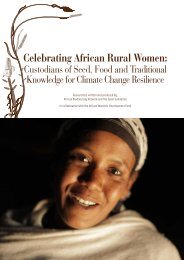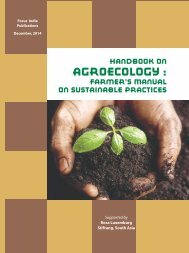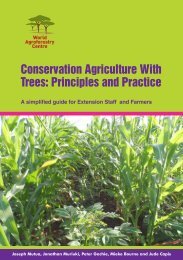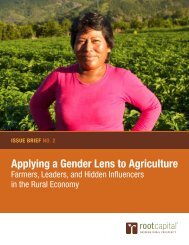1t0SC7l
1t0SC7l
1t0SC7l
Create successful ePaper yourself
Turn your PDF publications into a flip-book with our unique Google optimized e-Paper software.
The heat may, however, reduce the germination rate. Therefore, women may pre-germinate<br />
maize (soaking seeds in water for 2 to 3 days) before seeding into the field. Seeds used for<br />
planting are from the preceding harvest, from the neighbours, or bought on the market.<br />
Weeds, pests and diseases. Weeds in the zone comprise broadleaf weeds and grasses.<br />
Chromolaena odorata is the dominant weed. Like many other weeds, it is manually controlled<br />
by the farmers, using hoe and hand pulling. Weeding is done only once, at flowering in the<br />
groundnut field, and during re-densification 2 of cassava five to six months after planting. Weeds<br />
are hand-pulled and stacked under a tree or on the ground in the middle of the field. The ngon<br />
field is not weeded; the ngon vines climb on trunks and branches of felled trees out of the reach<br />
of weeds. It is common to find large crop fields invaded by weeds because of labour shortage.<br />
Throughout the growing season, crops are exposed to grasscutters, grasshoppers, porcupines,<br />
birds, locusts (Zonocerus variegates) and domestic animal attacks. The harvest in storage is<br />
damaged by weevils. Maize in the field is subject to streak and stem borer attacks. Cassava and<br />
cocoyam tubers are susceptible to root rot; plantain suffers from nematode attacks. There is<br />
difficulty growing cowpea (Vigna inguiculata) or soybean in the zone. All efforts in growing<br />
these crops in research stations failed because of aphids, thrips and pod borers.<br />
Harvesting and processing. All harvesting and processing operations are done manually.<br />
Women carry most of the produce to the villages, part of the harvest will be sold and part<br />
consumed. In remote villages, most of the harvest is for family consumption; a small part of the<br />
rest may be sold and another part kept as seeds for next season planting. Nearly all crops are<br />
harvested progressively, and time and labour are no constraints, but groundnut harvest must be<br />
done once, to prevent pods from getting rotten in the ground; therefore the operation is<br />
considered time-consuming and labour demanding by the farmers. Processing operations<br />
concern palm wine and some crops. Cassava may be processed into flour to make ’fufu’ or<br />
transformed into 'gari', 'engouda', 'beignet', 'miondo', 'bobolo' and 'mintumba'. Cassava and<br />
maize may be fermented for use as raw material to make ‘arki’, an alcoholic beverage. Palm<br />
wine distillation gives an alcoholic beverage called ‘odontol’. Sugar cane is transformed into<br />
‘melanba’, also an alcoholic beverage, after four days of fermentation.<br />
Home garden<br />
A home garden is a limited space around the compound where the farmer maintains an<br />
ecosystem composed of useful domesticated forest trees, local and introduced fruit trees, annual<br />
/ biannual and perennial food crops, and where he can have easy access day and night. In the<br />
Centre Province of Cameroon, Tchatat et al. (1996) reported the presence of 124 plant species<br />
in the home garden, excluding weeds and ornamental plants. Domestic animals are also part of<br />
the home garden: goat, pig, chicken, sheep and duck. Domesticated forest trees produce fruits<br />
(Irvingia gabonensis, Trichoscypha sp., Cola sp. etc.), spices (Ricinodendron heudelotii,<br />
Irvingia gabonensis, Monodora myristica, etc.), medicine (Alstonia boonei, Voacanga spp.) and<br />
can also be of multiple uses: ‘caterpillar trees’ such as Triplochiton scleroxylon and<br />
Petersianthus macrocarpus (Tchatat et al., 1996), firewood, wood work and construction<br />
(Baillonella toxisperma, Mansonia altissima, Pterocarpus soyauxii). Local tree fruits are safout<br />
(Dacryodes edulis) and cola (Cola spp.). Introduced fruit trees are: mango, avocado, citrus,<br />
orange, guava, papaya, grapefruit, 'corossolier', etc.<br />
The role of the home garden is to diversify the production of the farmer and to continuously<br />
supply him with produce, allowing him to go through the period of food shortage (April-May)<br />
with fewer difficulties. Also, the home garden is the place where some useful plant species<br />
threatened to disappear by forest exploitation are conserved, such as Trichoscypha, Irvingia and<br />
Dacryodes macrophylla. Home garden is the land use system continuously managed by the<br />
2 Increasing density of the remaining crop after the first crops are harvested<br />
20








